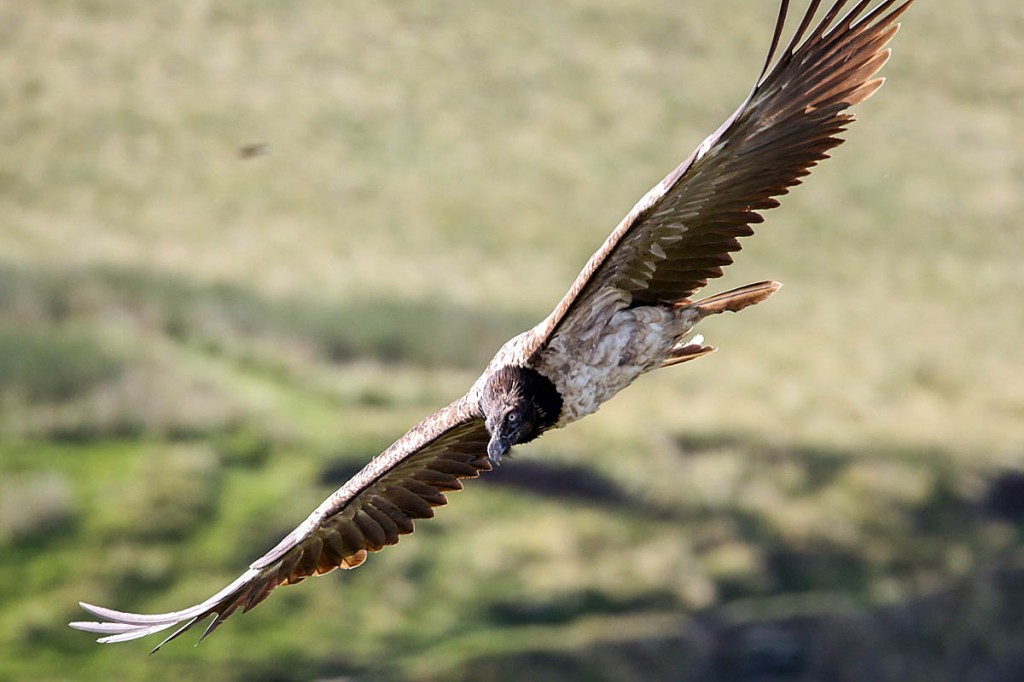The boss of the Peak District national park said the interest caused by the visit of a rare vulture to the area is testament to the importance of wildlife to the park.
A bearded vulture, also known as a lammergeier, has appeared on the moors above the Derwent Valley.
The large raptor, which feeds mainly on the bones of animals, is not native to the UK and is likely to have flown from the European Alps, the Pyrenees or Picos de Europa.
Bird watchers have flocked to the area for a sighting of the vulture. There has only been one other recent recorded visit of a bearded vulture, on Dartmoor four years ago.
Sarah Fowler, chief executive of the Peak District National Park Authority, said: “In a year that was already written into the history books by the unusual and unprecedented, no-one in the Peak District expected our skies to be graced by one of Europe’s most magnificent and rarest birds.
“The arrival of a bearded vulture to the Dark Peak has understandably become a source of wonder and excitement in recent weeks, not only for those who carry a passion for nature, but others who simply wish to marvel at a bird of prey larger than anything ever witnessed in our almost 70 years as a national park.
“The vulture’s appearance at a time when many of us were taking the first steps back into nature since lockdown has no doubt added to its popularity as a ‘must-see’ for wildlife watchers.
“Such widespread interest also demonstrates the power of birds of prey as a gateway to a wider discovery of our wildlife. Witnessing the return of the osprey, white-tailed eagle and red kite to UK skies has in turn shown the multi-million pound economic contribution these species can make through nature-based tourism.
“These are also flagship species that thrive when we are getting things right in our protected landscapes, whether within our 15 UK national parks and areas of outstanding natural beauty, or across Europe from where our bearded vulture made its headline-grabbing flight.”
Ms Fowler said there is still some way to go in achieving the same recognition for native raptors in the Peak District, but progress is evident.
“This recent breeding season has once again shown the green shoots of recovery continue to grow, with species such as peregrine and goshawk in the Dark Peak nesting successfully across multiple locations. Wildlife crime remains a factor in this progress, not only in our bird of prey initiative study area where the bearded vulture has made its temporary home, but elsewhere in the national park where police and others continue to work on tackling criminality impacting on our raptors.
“While this most recent visitor is unlikely to be a long-term fixture due to our seasonal conditions not matching that of its Alps or Pyrenees home, the bearded vulture offers a glimpse of a future where nature-based tourism is an integral part of our already rich offer for visitors to explore.
“Such significant and specific interest in our national park does not come without its challenges. Maintaining responsible visitor activity; car parking, accessing land appropriately and leaving the outdoors as we find it are all part of the picture.
“I would particularly like to thank those who have supported the presence of the bearded vulture whilst keeping the ethos of being ‘Peak District proud’ at the heart of visitors’ experiences.”
The chief executive said the fact the lammergeier seemed confident to stay within a modest area of the national park was testament to those working as custodians of protected landscapes. She acknowledged the work of the National Trust and Derbyshire Wildlife Trust, local volunteers, landowners, gamekeepers and land managers who have all positively welcomed the vulture’s ground-breaking presence and supported its wellbeing.
“For those yet to visit us for a chance to witness this remarkable sight, I would urge you to ‘know before you go’ – understand where you can park safely, plan your trip and route carefully and always have the vulture’s welfare as your utmost priority above a slightly closer view or more engaging photograph,” she said. Spending a penny, or a pound in our local communities will also help our Peak District businesses to continue to build their resilience against the effects of Covid-19.
“Whilst the bearded vulture remains a very welcome visitor, as summer turns to autumn our attention will naturally turn to its own welfare in our changeable weather conditions.
“Although any intervention remains a last resort, conservation experts both locally and from the continent are already exploring how the bird may be returned safely to its home reintroduction area, as all individual bearded vultures remain vital to the scheme.”
Experts say the bearded vulture, which is not ringed or tagged, is the same one that was spotted in the Netherlands and Belgium before crossing the sea to England. The species regularly carries the bones of small mammals to heights of 100m before dropping them on to rocks to enable them to access the bone marrow on which they feed.
The German alternative name of lammergeier erroneously implies they feed on lambs, which has led to their persecution in Europe.

Steven Porter
08 August 2020Obviously Sarah Fowler wasn't involved in the Derbyshire Wildlife Trusts Webinar on 8/8/20 regarding birds of prey or she would have heard how badly birds of prey and other predatory species are doing in the Dark Peak. With the interest in the Bearded Vulture bringing visitors the Dark Peak I think the same thing would happen if we had a healthy and thriving bird of prey population. The persecution of these species is against the law and the perpetrators and the people who employ them should be made accountable. I think it's questionable if driven Grouse shooting should actually be allowed in a National Park.
Ian Johnston
09 August 20203 Griffon vultures flew over the Surprise View 30 years ago